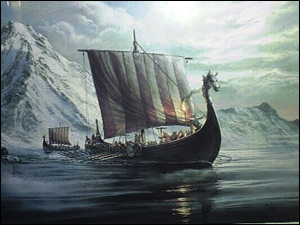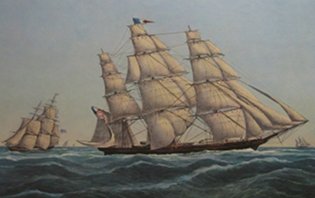 No, Christopher Columbus probably wasn't the first European to discover the Americas.
No, Christopher Columbus probably wasn't the first European to discover the Americas.
The history we learn in school is, understandably, Central Eurocentric, and the contributions from the Northern Europeans, aka 'Scandinavians', has decidedly been given short shrift over the years.
But in the past decade or so, more attention has been paid to the role the Norsemen played, and it's becoming fairly apparent that not only did Eric The Red or his son discover and colonize Greenland, but made it all the way to Newfoundland, a country he dubbed Vinland.
But wait!
'Vinland' in Norse means Wineland — and how could an ice block like Newfoundland be warm enough to grow grapes?
Of course, you're probably already ahead of me here. When the Vikings made their voyages, the earth was so warm that not only could Greenland be colonized and sustain crops (and be named Greenland in the process), but Newfoundland was warm enough to grow grapes.
And not an SUV in sight. Imagine that.
But wait again! The Vikings had no instruments to guide themselves as they crossed the vast Atlantic. No dipping needle, no compass, no clock, not even a sand glass, and certainly no astrolabe or sextant. All they had were the stars above, and since the stars rotate in a circular pattern overhead, all they could do was measure a star's height against a knot tied in a rigging line (on a bouncing ship, no less) and make their best guess.
Okay, so how did they discover Iceland, Greenland, and later Newfoundland, without any instruments aboard?
The same way Noah discovered land after the Great Flood.
That's how.
First off, my thanks to Cap'n Tom for steering me toward the superb novel, The Master Mariner, from which I gleaned these fascinating bits of info.
After the rain stopped falling and the floodwaters began to recede, Noah released a dove. A dove is what is referred to as a "shore-seeking" bird. It returned a while later and the ark bravely plundered on.
A week later, Noah released another dove, and this time it returned with an olive branch in its beak. This indicated that there were treetops showing. Then a third was released, and never returned. It had found land, and that was the direction they headed.
The Vikings used ravens.
"Then a third was let go, and sped away, and never returned. What did that mean?"
"That there was land to settle on, at last."
"I'll warrant you! And so it was with the ravens carried by the Norsemen, though they added more skill to it. When they wanted to divine where was the nearest land, or the new land they sought, they released their shore-sighting birds. Sometimes these flew homewards, sometime they returned to the ship in puzzlement, sometimes they set off on a new course — north, or west, or south — and never returned. So that way lay the land."
"But what land?"
"What land indeed! The sailors must travel there to find out, and thus was the world enlarged. Sometimes, when all else failed, and they were truly lost, they followed the great skeins of geese, winging and barking all the way from Ireland where they spent the winter, to Iceland or Greenland which was their summer breeding ground."
The earth was so warm at the time that Iceland and Greenland were the birds' summer breeding grounds.
And not an SUV in sight. Imagine that.
I am not, however, claiming that the Vikings should be given the honor of First Discoverers. The Magellan Matter is different, because it was clearly a fraud perpetrated by Spain's PR department, whereas in this case some actual proof is required, and there simply is none.
But an honorary title is better than nothing.


 No, Christopher Columbus probably wasn't the first European to discover the Americas.
No, Christopher Columbus probably wasn't the first European to discover the Americas.
These are what I consider my better pieces: "Do these genes make me look fat?" — As these things go, this is probably the most official 'exposé' on the site. It's amazing how we're being lied to. Beautiful Camp Elmwood — I just l
Tracked: May 06, 17:21